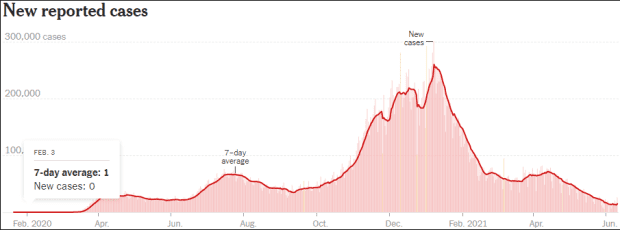# New U.S. COVID-19 cases and deaths jump to two weeks highs

Table of Contents
“#
New U.S. COVID-19 cases and deaths jump to two weeks highs
”
U.S. adults receiving at least one vaccine dose rose to 64.1% of the adult population
The number of new daily COVID-19 cases and deaths in the U.S. jumped to the highest levels in more than two weeks, as the daily vaccination rate continues to suggest President Biden’s goal won’t be met.
There were at least 26,076 new cases of the coronavirus-borne illness in the U.S. on Friday, up from 13,981 on Thursday, according to a New York Times tracker. The seven-day average rose to 14,772 from 12,888, but was down 33% from two weeks ago.
The new daily case and death counts were the highest since May 27.
The number of U.S. states showing an increase in the weekly trend ticked up to 13, as of Saturday morning, from 12 on Friday, according to data aggregated by Johns Hopkins University.

New York Times
On the vaccination front, 165.39 million people in the U.S. aged 18 years and older have received at least one dose, or 64.1% of the adult population, according to the latest data from the Centers for Disease Control and Prevention, which is up from 165.12 million Americans as of Friday afternoon.
At that daily pace of vaccinations, the U.S. will fall well short of Biden’s goal of 70% of adult Americans receiving at least one shot by the Fourth of July. About 15.22 million more adults need to get one vaccine dose to reach Biden’s goal, based on a MarketWatch analysis of CDC data, which translates to a little under 700,000 a day.
The number of fully vaccinated Americans rose to 142.10 million, or 42.8% of the total U.S. population.
Within age groups, 50.7% of Americans who are at least 12 years old are fully vaccinated, as are 53.6% of the U.S. adult population and 75.9% of Americans at least 65 years old.
In the U.S., fully vaccinated means it has been two weeks since the second of the two-dose vaccines developed by Pfizer Inc.
PFE,
and partner BioNTech SE
BNTX,
or Moderna Inc.
MRNA,
have been administered, or it’s been two weeks since receiving the lone dose of Johnson & Johnson’s
JNJ,
vaccine.
The World Health Organization put out a statement to healthcare professionals on Friday, on how COVID-19 vaccines authorized for use around the world are regulated for safety and effectiveness, in an effort to help combat vaccine hesitancy. The WHO stressed that vaccines “play a critical role’ in preventing deaths and hospitalizations.
“Reports of adverse events (side effects) have led some people to express concerns about getting vaccinated, delay getting vaccinated or even be strongly opposed to vaccination,” the WHO statement said.
“Clear and consistent communications is therefore essential to support people in making the choice to be vaccinated,” the WHO said.
For mRNA-based vaccines, including those from Pfizer-BioNTech and Moderna, the major adverse event is anaphylaxis, but the WHO said reports of anaphlylaxix remain “very rare,” in the order of 10 cases per million vaccinated. Regulators are monitoring and reviewing the reports and cases to determine whether there is a causal relationship between the vaccines and anaphylaxis.
Reports circulated on Friday about myocarditis in teens, or heart inflammation, as a possible rare side effect of mRNA vaccines. Dr. Ashish Jha, a Brown University dean, said on NBC’s “Today” that almost all the cases of myocarditis are “incredibly mild” and people recover “very, very quickly.”
He added: “[Y]our risk of having complications from [COVID-19] infection remain way higher than your risk from vaccines.”
Adenovirus vector vaccines, including the J&J vaccine, have been associated with “very rare and unusual clotting syndrome” involving blood clots and low blood platelet count, the WHO said. The condition has been termed Thrombosis with Thrombocytopenia Syndrome (TTS).
“The overall number of reports received of blood clots in the veins or arteries (including venous thrombosis or venous thromboembolism) occurring without thrombocytopenia is no higher than the expected background population rate for the more common type of blood clots in most countries,” the WHO said.
Latest tallies
The global case tally for the coronavirus-borne illness rose to 175.34 million as of Friday morning, while the death toll rose to 3,786,548, according to JHU data. The numbers of more than doubled year to date, as there were just under 83 million total cases at the end of 2020 and about 1.8 million deaths.
There have been 2.31 million vaccine doses administered worldwide, the data show.
The U.S. leads the world in total cases with 33.44 million and deaths with 599,181.
India continues to move closer to the U.S., with cases rising to 29.36 million, but is third in the world in deaths with 367,081.
Brazil is second in deaths at 484,235 and third in cases with 17.30 million.
The U.K. is fourth in deaths worldwide, and it leads Europe, at 28,148, while France is fourth globally in cases and leads Europe with 5.80 million.
China, where the virus was first discovered late in 2019, has had 103,323 cases and has held steady at 4,846 deaths, according to its official numbers, which are widely held to be massively underreported
By
Tomi Kilgore
If you liked the article, do not forget to share it with your friends. Follow us on Google News too, click on the star and choose us from your favorites.
For forums sites go to Forum.BuradaBiliyorum.Com
If you want to read more News articles, you can visit our News category.